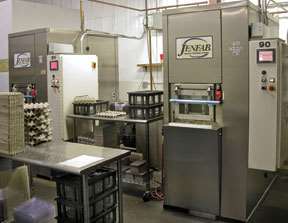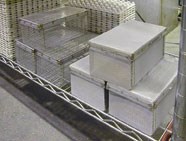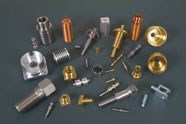Now, Even the Cleaning Aisle is Clean
When cleaning parts becomes the bottleneck of the production line, it puts both quality and profit at risk. And that’s exactly what was happening at C&M Machine Products Inc.
When cleaning parts becomes the bottleneck of the production line, it puts both quality and profit at risk. And that’s exactly what was happening at C&M Machine Products Inc., in Hudson, New Hampshire.
"The cleaning process was a manual operation, with drainage screens over buckets and compressed air blow-off of the remaining mineral spirits. Parts carts were literally lined up and jamming the cleaning aisle," says Eugene Fantozzi, general manager. "Now, a single person handles the volume of all three shifts, cleaning parts from scores of Citizen screw machines, Tsugamis, Eurotechs and several Stars."
Featured Content
C&M is a high-precision screw machine parts manufacturer making a wide range of products, from plasma cutting components to proximity switches and laser sights, for a broad range of markets, including industrial automation, firearms, medical, aerospace and office automation. Since plating is done on up to 70 percent of the parts C&M manufactures, the cleaning problem was also an expensive one: Outside platers were required to perform additional cleaning and in some cases, aggressive etching of the parts, cutting into profit margins and increasing the reject rate. Fantozzi set out to address the problem with the hopes to eliminate the bottleneck and increase part quality control.
Retained oils are a challenge with the complex configurations and blind holes found in many of the small parts C&M makes. To remove these oils, the outside plating companies would use etching processes, but dimensional tolerances were adversely affected by the etching. This was especially troublesome on high-precision products with critical tolerances. The additional cleaning steps required to get the parts ready for plating actually resulted in a higher number of rejects.
In August of 2005, after careful review of a number of cleaning systems, C&M settled on Jenfab LeanClean 360 machines. A key determinant for selecting the Jenfab machines was their comparatively small footprint. Each Jenfab LeanClean machine fits into just 15 square feet. This allows C&M to accommodate two machines in roughly the same floorspace as a single machine from some other manufacturers.
The ability to deal with a responsive United States manufacturer was also key to the selection. As part of the decision-making process, C&M sent families of samples to Jenfab to evaluate prior to installation of any new systems. Jenfab and C&M worked to establish the most efficient processes and chemistries to achieve the desired results. Special baskets were developed by Jenfab to handle C&M’s smaller parts, and other baskets were created with fixturing designed to separate and support parts.
The final decision was to install two LeanClean machines—one for non-ferrous and the other for ferrous parts. Both units employ 25-kHz ultrasonics for precision cleaning of small-diameter threaded and precision parts. A rust inhibitor is used in one cycle on the ferrous unit. Each machine is fitted with an integral 10-kW dryer that recirculates 1,600 CFM for fast, spot-free drying. Up to eight baskets per hour can be processed.
The entire cleaning operation runs in a closed loop. Each aqueous LeanClean system has an oil coalescer, from which oil is extracted and wastewater is automatically pumped into a holding tank for elimination in an evaporator. In fact, C&M reports that it went from being a "large" waste producer to a "zero" producer and that the EPA and OSHA are also satisfied.
With the new cleaning process in place, the company avoids the nicks, dings and dimensional rejects that occurred as a result of the aggressive cleaning processes. The parts that the outside plating companies receive are now sufficiently clean. With the introduction of the new cleaning system, C&M also established lot control and stringent Kanban methods, depending upon the customer’s specific needs, to ensure both internal and external traceability.
At first, Fantozzi personally monitored the cleaning process every day. Since the initial start-up, the process has been up and running as established during this initial phase. Ferrous and non-ferrous pH levels are checked daily and the tanks are changed once a week.
"Our personnel especially like the stainless steel access panels, which get us inside the machines with minimal effort. The chip strainer baskets are easy to empty, too. Jenfab even included a hose with spray nozzle for wash-down or other purposes," Fantozzi says. "Little touches like that make the system a pleasure to use."
The machines have remained up and running consistently since installation, except for one minor hiccup. At one point, a vendor to Jenfab had difficulty with a batch of hoses that burst and caused liquid to escape from the system. Jenfab was quick to respond and the issue has since been resolved. Since installation, Jenfab personnel have only been required to address issues a couple of times in nearly five years.
C&M anticipates new, high-throughput cleaning requirements as it continues to grow its business and is looking at the inline, multi-station systems Jenfab offers as one option for its planned, 20,000-square-foot plant addition. "That way, we can proactively address any cleaning issue before it becomes a bottleneck and keep the cleaning aisles clean, too," Mr. Fantozzi says.
RELATED CONTENT
-
A Primer On Parts Washing—Here’s How To Get Your Parts Really Clean
Cleaning is loosely defined as the process of removing unwanted contaminants or dirt from a surface. It does not alter the surface physically or chemically. A properly cleaned surface is just the same as it was prior to cleaning, except it is missing the dirt.
-
The Importance of Drying Parts After Cleaning
Most cleaning processes consist of three steps, not two: wash, rinse and dry. That drying step is absolutely necessary for everything from product finishing to product performance to effective throughput to product quality.
-
Cleanliness Compliance is Critical for Automotive Suppliers
Although not every shop has been affected by cleanliness specifications, many suppliers to automotive OEMs are already complying with stringent cleanliness standards. In Ford Motor Co.’s case, it has created its own cleanliness standards in order to save money and credibility.









